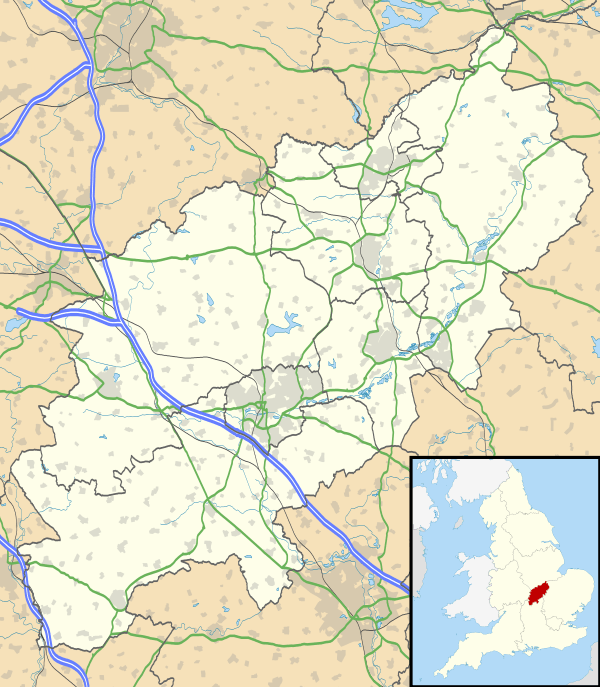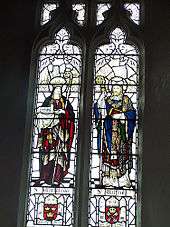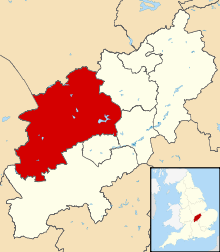Guilsborough
| Guilsborough | |
 Village sign |
|
 Guilsborough |
|
| Population | 692 (2011) |
|---|---|
| OS grid reference | SP6773 |
| District | Daventry |
| Shire county | Northamptonshire |
| Region | East Midlands |
| Country | England |
| Sovereign state | United Kingdom |
| Post town | Northampton |
| Postcode district | NN6 |
| Dialling code | 01604 |
| Police | Northamptonshire |
| Fire | Northamptonshire |
| Ambulance | East Midlands |
| EU Parliament | East Midlands |
| UK Parliament | Kettering |
|
|
Coordinates: 52°21′19″N 1°00′37″W / 52.3554°N 1.0103°W
Guilsborough is a village and civil parish in the Daventry district of the county of Northamptonshire in England. At the time of the 2001 census, the parish's population was 882 people,[1] reducing to 692 at the 2011 Census.[2]
It is at the centre of an area of rural villages between the towns of Northampton, Daventry, Rugby and Market Harborough. There is a secondary school, fire station, pub, a new village shop (formerly the doctor's surgery) and a new doctor's surgery. The secondary school is on the edge of the village and takes children from 11 to 16. It also has a sixth form. Guilsborough School is in the top 500 schools for GCSE and A levels. It takes children from surrounding villages and has about 1,500 pupils. The school currently has technology college status.
History
Guilsborough is made up of two hamlets, now joined. Guilsborough (Guildesburgh) and Nortoft. The former referring to the Roman fort and the latter to Scandinavian settlers. The Church Mount road housing stands where Guilsborough Hall once stood. The mount is separated from the main road by a large embankment which is the remains of a Roman wall. The wall was part of a Roman fort, an outpost of the settlement at West Haddon. The encampment is believed to have been the work of Publius Ostorius Scapula, under the reign of Claudius. The larger part of the camp walls have long since been removed and it is noted that, when the south bank was removed in the 19th century, many skeletons were found.[3] The fields behind Church Mount not only include Roman remains but also a historical landscape related to the former Guilsborough Hall. The brick water tower of the hall and the hall gates still remain.

In the two fields below Nortoft ('Northern Clearing') at the spring line below the Ironstone, lies the remains of a medieval village, with house platforms and the remnants of a track still visible. Local knowledge suggest that the village burnt down, but as yet there is not collaborative evidence. Nortoft Cottage, which has a very old cob cottage at its heart is thought to be the only remaining building of the original Nortoft. There is also other archaeological evidence that these Nortoft fields (on both sides of Nortoft [road]) were Saxon fishponds, fed by water from the springline. A cell of Premonstratensian canons was founded at Kalendar or Kayland (on the border of Guilsborough and Cottesbrooke Parishes near Nortoft), probably soon after Sulby Abbey (c1155), and as it does not appear in the taxation of 1291, had probably ceased by then. The Kayland meadow held a cell of Premonstratension canons. Large foundation stones have been dug up and the cell appears to have been moated (English Heritage Pastscapes 341939) and possible fishponds.
Folklore
The Guilsborough Witches
On 22 July 1612, four women and one man were hanged at Abington Gallows in Northampton for the crime of witchcraft, also known as the Northamptonshire Witch Trials. Of those five, Agnes Brown and her daughter Ioane/Joan Vaughan (or Varnham) were from Guilsborough. They stood accused of bewitching a local noblewoman, Elizabeth Belcher (née Fisher) and her brother-in-law Master Avery and of killing, by sorcery, a child and numerous livestock.[4][5][6]
Although the hangings can be legitimately traced back to actual historic events, the story most commonly repeated is of less certain origins. The tale goes that there was an elderly witch called Mother Roades, who lived just outside the neighbouring village of Ravensthorpe. Before she could be arrested and tried for her crimes of sorcery, she died. Her final words told of her friends riding to see her, but that it did not matter because they would meet again in some other place before the month was out.

Her friends were thus apprehended riding on the back of a sow between Guilsborough and Ravensthorpe and were taken into custody and hanged, thus they were all reunited in death. The problem with this story is that, although Agnes Brown remains a constant upon the pig's back, her companions swap names depending on the version being read. Three witches were on the pig, but the potential riders, other than Agnes Brown (who appears as one of the riders in all versions), are: Kathryn Gardiner, Alice Abbott, Alice Harrys and Ioan/Joan Lucas. It would appear from records that all of these accused stood trial together, however the reporting only covers the hangings of one day in 1612, so the fates of the others are not known.[7]
Pell's Pool
Guilsborough used to have its own version of Black Annis who lived in Pell's Pool. This was a deep pool which stood off Cold Ashby Lane and was used by the local fire service as a water supply for many years. The pool has now dried up and a house stands there. Young boys and girls were told not to go walking by the pool at night otherwise a witch would drag them down into the water.
Landmarks
Saint Etheldreda's Church

The church was possibly a minster of Brixworth, which is one of the oldest remaining Saxon churches in England. There are Saxon remnants among the Norman architecture of Guilsborough church. There are rumours that it may have been founded by Saint Wilfred; however these probably belong to the realm of myth and legend. This church was originally dedicated to St Wilfred and it is unusual to see a renaming in favour of a female saint. However, Wilfred and Etheldreda's paths are said to have crossed when Wilfred supported the Anglian Queen's decision not to grant her second husband conjugal rights. Despite having been married once before, it is said that St Etheldreda (also known as St Audrey, from where the word 'tawdry' originates) remained a virgin.[8]

Another unusual aspect to this saint is that she appears to have two saint days. The most commonly cited day is 21 June, however, certainly around the 17th century, villagers in Guilsborough were celebrating her feast day on the first Sunday after 17 October.[9]
The Renton family
Ethel Renton and her daughter, Eleanor Friedberger (née Renton), were prolific local historians writing in the 1920s. To commemorate the millennium, their work was republished as: The Records of Guilsborough, Nortoft and Hollowell. This was originally published in 1929 by T. Beaty Hart Ltd, Bridewell Printing Works, Kettering. The Rentons were also heavily involved in the local Women's Institute and were responsible for the tapestry of the witches in the village hall. The Rentons lived at Guilsborough House.[10]
See also
References
- ↑ Office for National Statistics: Guilsborough CP: Parish headcounts. Retrieved 10 November 2009
- ↑ "Civil Parish population 2011". Neighbourhood Statistics. Office for National Statistics. Retrieved 4 July 2016.
- ↑ Ethel Renton, Eleanor Friedberger, The Records of Guilsborough, Nortoft and Hollowell, 1929, by T. Beaty Hart Ltd, Bridewell Printing Works, Kettering.
- ↑ A Brief History of Witchcraft Relating to The Witches of Northamptonshire Reprinted by Taylor & Son 1867. Facsimile by General Coe Ltd, Wilbarston, Northants; April 1967
- ↑ Witchcraft and Demonianism by C. L'Estrange Ewen 1970
- ↑ Witchcraft in England 1558-1618 edited by Barbara Rosen 1991.
- ↑ Witchcraft and Demonianism by C. L'Estrange Ewen 1970, pps. 211-1
- ↑ The Oxford Book of Saints
- ↑ Dissertation by T.R. Slater 1982, Northamptonshire Records Office
- ↑ "Engagement announcement: Ivor Mathews Hedley, youngest son of Dr. & Mrs. Hedley, Cleveland Lodge, Middlesbrough, and Sylvia Ethel Renton, daughter of the late W. Gordon Renton, of Guilsborough House, Northampton & the late Mrs. Renton". The Times. 4 December 1923. p. 15. Retrieved 14 February 2016.
External links
![]() Media related to Guilsborough at Wikimedia Commons
Media related to Guilsborough at Wikimedia Commons
